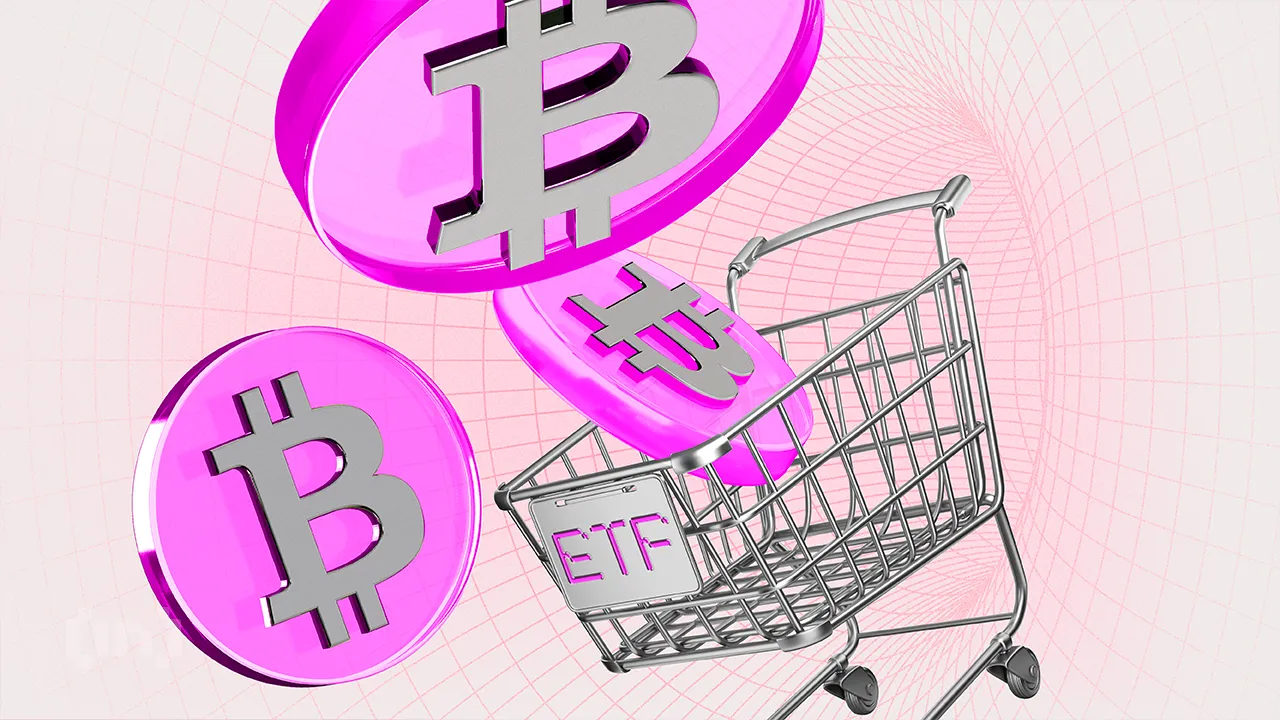Bitcoin
How Trump’s Tariffs Threaten Bitcoin Mining in the US

According to a recent report, President Trump’s new tariffs may fundamentally shift the dynamics of global Bitcoin (BTC) mining, making the US less competitive than other countries.
The tariffs, announced by the Trump administration on April 2, are set to escalate the cost of essential mining equipment, impacting imports and even the global hashrate.
Impact of Trump’s Tariffs on Bitcoin Mining
Jaran Mellerud, CEO of Hashlabs Mining, highlighted that new reciprocal tariffs would increase the cost of importing mining machines to the US by at least 24% compared to tariff-free countries like Finland.
Notably, the US is heavily reliant on Bitcoin mining hardware produced in Southeast Asia, especially by companies like Bitmain, MicroBT, and Canaan. He explained that while a 25% tariff on machines imported from China has been in effect for several years, manufacturers managed to sidestep it by relocating production to Southeast Asia.
“This strategy was effective until earlier this month when Trump raised tariffs on goods imported from Indonesia, Malaysia, and Thailand to 32%, 24%, and 36%, respectively,” Mellerud stated.
As a result, these manufacturers can no longer fully avoid these steep tariffs. Therefore, the demand would decrease, and in turn, manufacturers may find themselves with surplus equipment. To clear this excess inventory, they may be forced to lower prices to appeal to buyers in other regions.
“While it’s difficult to predict exactly how much machine prices will fall—since mining profitability also plays a role—we can confidently say that, based on basic economic principles, a decrease in demand for an asset typically leads to a drop in its price,” the report read.
Bitcoin Hashrate Redistribution Likely as US Mining Costs Rise
Meanwhile, the repercussions of Trump’s tariff hikes go beyond just rising Bitcoin mining equipment prices. The US, which currently accounts for approximately 36% of the global Bitcoin mining hashrate, is at risk of seeing its share of the market shrink.

Higher operational costs in the US will make it less attractive for miners to expand their operations. Nonetheless, miners in countries unaffected by the tariffs could gain a competitive edge.
“In the broader picture, this may lead to a more geographically diverse Bitcoin mining landscape than ever before. While the US will remain a major player, its dominance will fade, giving rise to a more globally distributed hashrate,” Mellerud remarked.
In addition, the absence of significant US expansion could reduce the global growth rate. In the short to medium term (the next 1-2 years), global hashrate growth could be slower than anticipated. However, the report emphasized that it’s unlikely that the US mining sector will stop growing completely.
“The assumption of a 36% reduction in global hashrate growth should be seen as an absolute upper limit— the actual impact will likely be somewhat lower,” Mellerud stated.
Moreover, in the longer term, if US mining growth slows, miners in other countries may increase their expansion to fill the gap.
Mellerud also pointed out that even if Trump reverses the tariffs, the damage to long-term investor confidence cannot be undone. The sudden implementation has made it harder for investors to commit to large-scale, long-term investments in the US mining industry. This unpredictability creates a challenging environment for attracting the capital needed for sustained growth.
“In an industry as capital-intensive as bitcoin mining, policy stability is crucial—and right now, that’s in short supply,” he said.
President Trump’s decision to impose reciprocal tariffs has triggered a broader stock and cryptocurrency market crash. According to BeInCrypto, the President’s move to implement a 104% tariff on imports from China led to a significant downturn in Bitcoin. The largest cryptocurrency fell briefly below $75,000.
Furthermore, the total global cryptocurrency market capitalization fell by 6.0% over the past day, highlighting the far-reaching consequences of this policy.
Disclaimer
In adherence to the Trust Project guidelines, BeInCrypto is committed to unbiased, transparent reporting. This news article aims to provide accurate, timely information. However, readers are advised to verify facts independently and consult with a professional before making any decisions based on this content. Please note that our Terms and Conditions, Privacy Policy, and Disclaimers have been updated.
Bitcoin
Bolivia Reverses Crypto-for-Fuel Plan Amid Energy Crisis


Bolivia’s Ministry of Trade and Imports has rejected a state-backed plan to use cryptocurrency for fuel imports.
This move, which marks a stunning policy reversal, signals a retreat from the government’s recent push to adopt digital assets as a workaround for dollar shortages.
Bolivia Rejects Crypto-for-Fuel Scheme Amid Energy Sector Turmoil
The initial plan, announced in March by Bolivia’s state-owned energy giant YPFB, aimed to use crypto to secure fuel imports. This was in response to acute shortages of both US dollars and refined fuel.
As reported by Reuters on March 13, the proposal had received government backing at the time.
But in a statement released Tuesday, Director of Trade and Imports Marcos Duran clarified that YPFB will not be permitted to use crypto for international transactions.
“YPFB must use Bolivia’s own resources and dollar-based financial transfers,” Duran said.
Head of digital assets at VanEck, Mathew Sigel, labels this a clear U-turn on crypto policy.
“U-Turn: Bolivia appears to back away from its crypto-for-fuel scheme,” Sigel quipped.
Disclaimer
In adherence to the Trust Project guidelines, BeInCrypto is committed to unbiased, transparent reporting. This news article aims to provide accurate, timely information. However, readers are advised to verify facts independently and consult with a professional before making any decisions based on this content. Please note that our Terms and Conditions, Privacy Policy, and Disclaimers have been updated.
Bitcoin
Bitcoin Poised for Summer Rally as Gold Leads and Liquidity Peaks

The crypto market and broader economy are moving fast as global liquidity reached an all-time high in April 2025. Gold has already broken past $3,200, setting a new record. Meanwhile, Bitcoin is still 30% below its previous peak.
Amid this backdrop, analysts are taking a closer look at the link between Bitcoin and gold. Fresh data also shows strong corporate demand for Bitcoin, with record levels of buying in Q1 2025.
What Bitcoin’s Ties to Gold and Liquidity Signal for Its Price
According to Joe Consorti, Head of Growth at Theya, Bitcoin tends to follow gold’s lead with a lag of about 100 to 150 days. A chart shared by Consorti on X, based on Bloomberg data, illustrates this trend from 2019 to April 14, 2025.
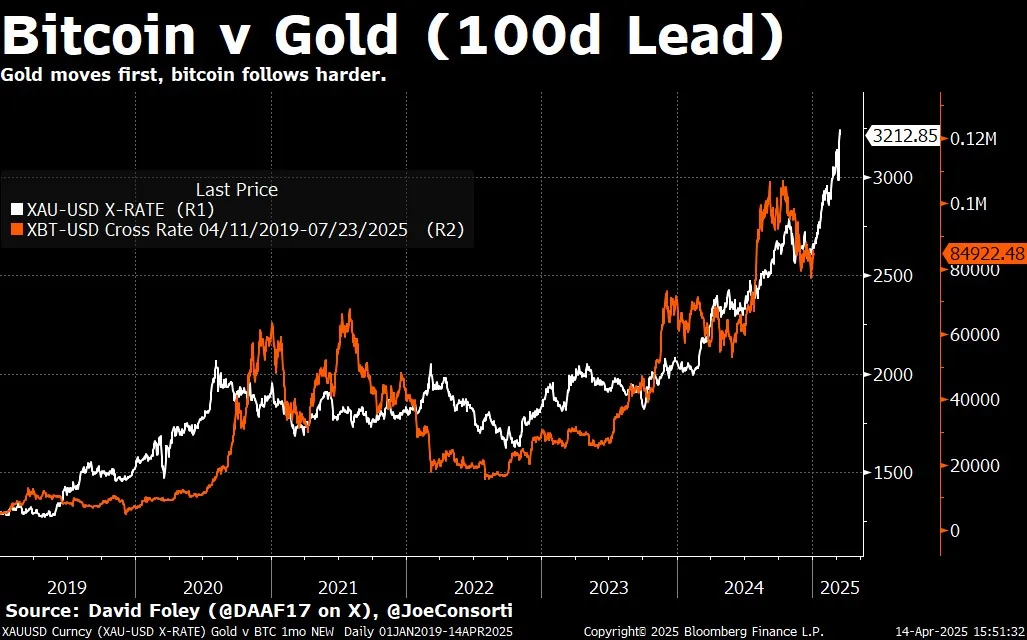
The chart shows gold (XAU/USD) in white and Bitcoin (XBT/USD) in orange. The data reveals that gold usually moves first during upswings, but Bitcoin often rallies harder afterward—especially when global liquidity is rising.
“When the printer roars to life, gold sniffs it out first, then Bitcoin follows harder,” Consorti said.
That 100-to-150-day lag is notable. It suggests Bitcoin could be set for a sharp move higher within the next 3 to 4 months. The recent surge in global liquidity also supports this view.
According to analyst Root, M2 money supply from major central banks—including the US Federal Reserve, European Central Bank (ECB), People’s Bank of China (PBoC), Bank of Japan (BoJ), Bank of England (BoE), Reserve Bank of Australia (RBA), Bank of Canada (BoC), and others—has hit a record high as of April 2025.
The sharp rise points to more cash flowing through the global economy.
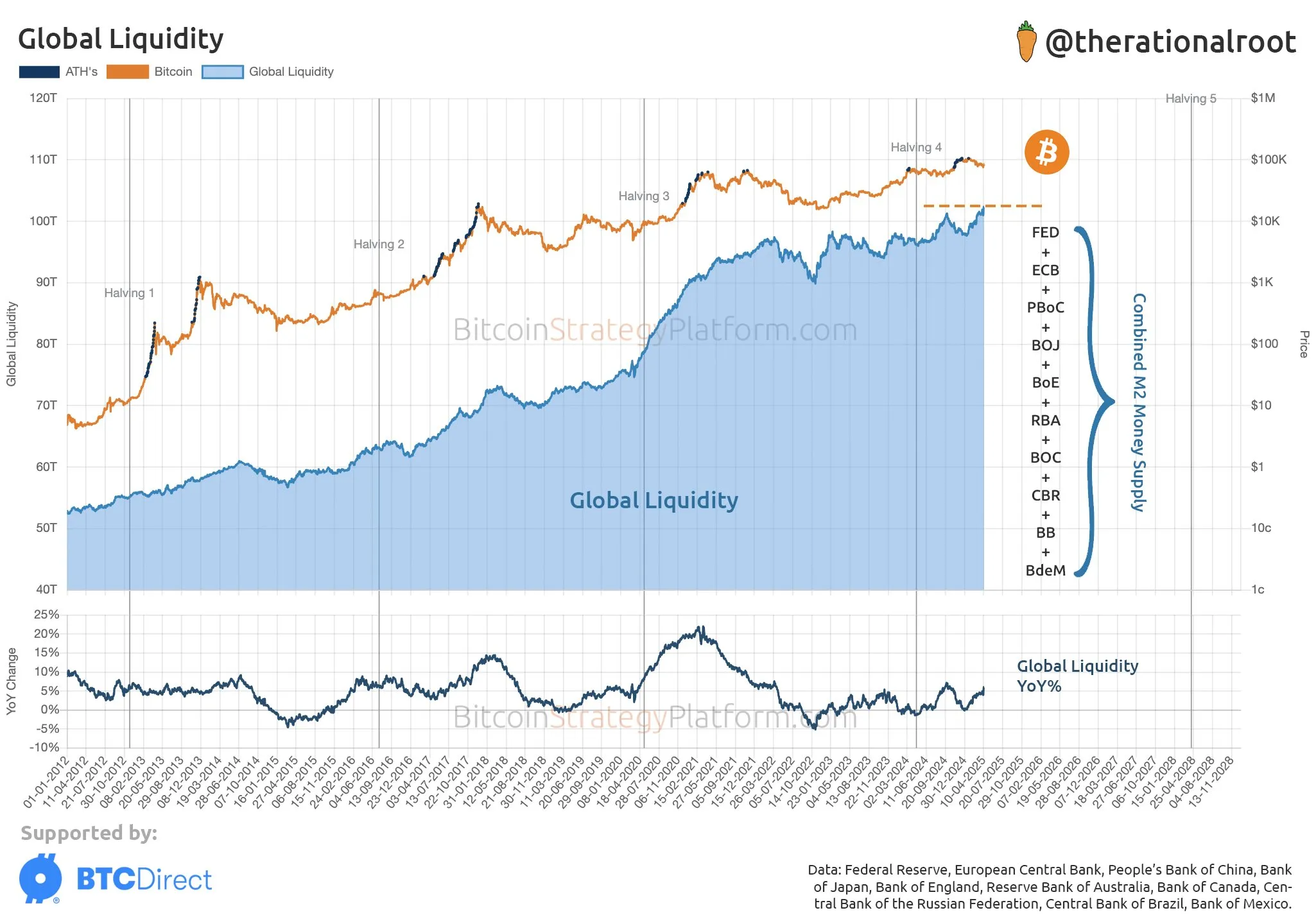
Historically, Bitcoin bull markets have often lined up with major increases in global liquidity, as more money in the system tends to push investors toward riskier assets like Bitcoin.
Why Bitcoin Might Outperform Gold and Stocks
Matt Hougan, Chief Investment Officer at Bitwise Invest, states that Bitcoin is not just outperforming gold but is also surpassing the S&P 500 in the long run. This indicates that Bitcoin is becoming a stronger investment option despite its price volatility.
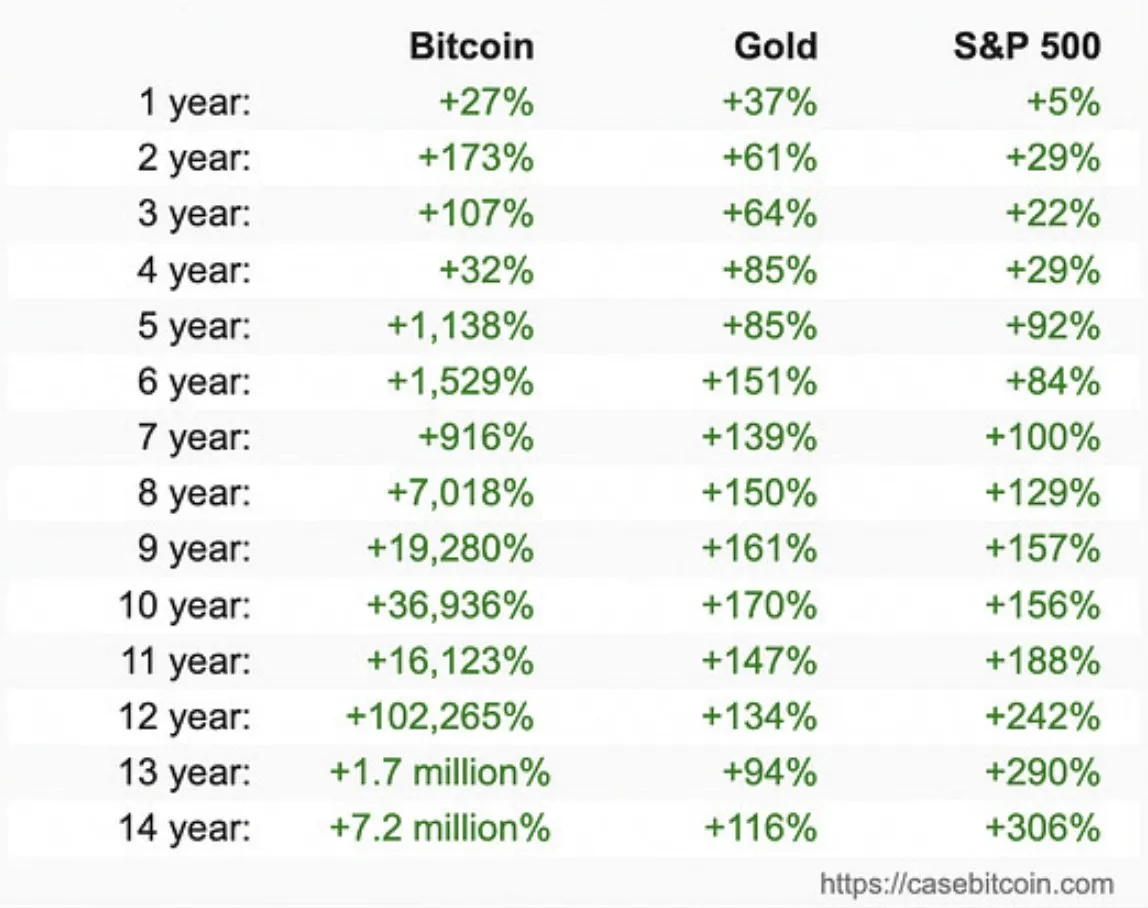
Data also supports this. A recent Bitwise report shows corporations bought over 95,400 BTC in Q1—about 0.5% of all Bitcoin in circulation. That makes it the largest quarter for corporate accumulation on record.
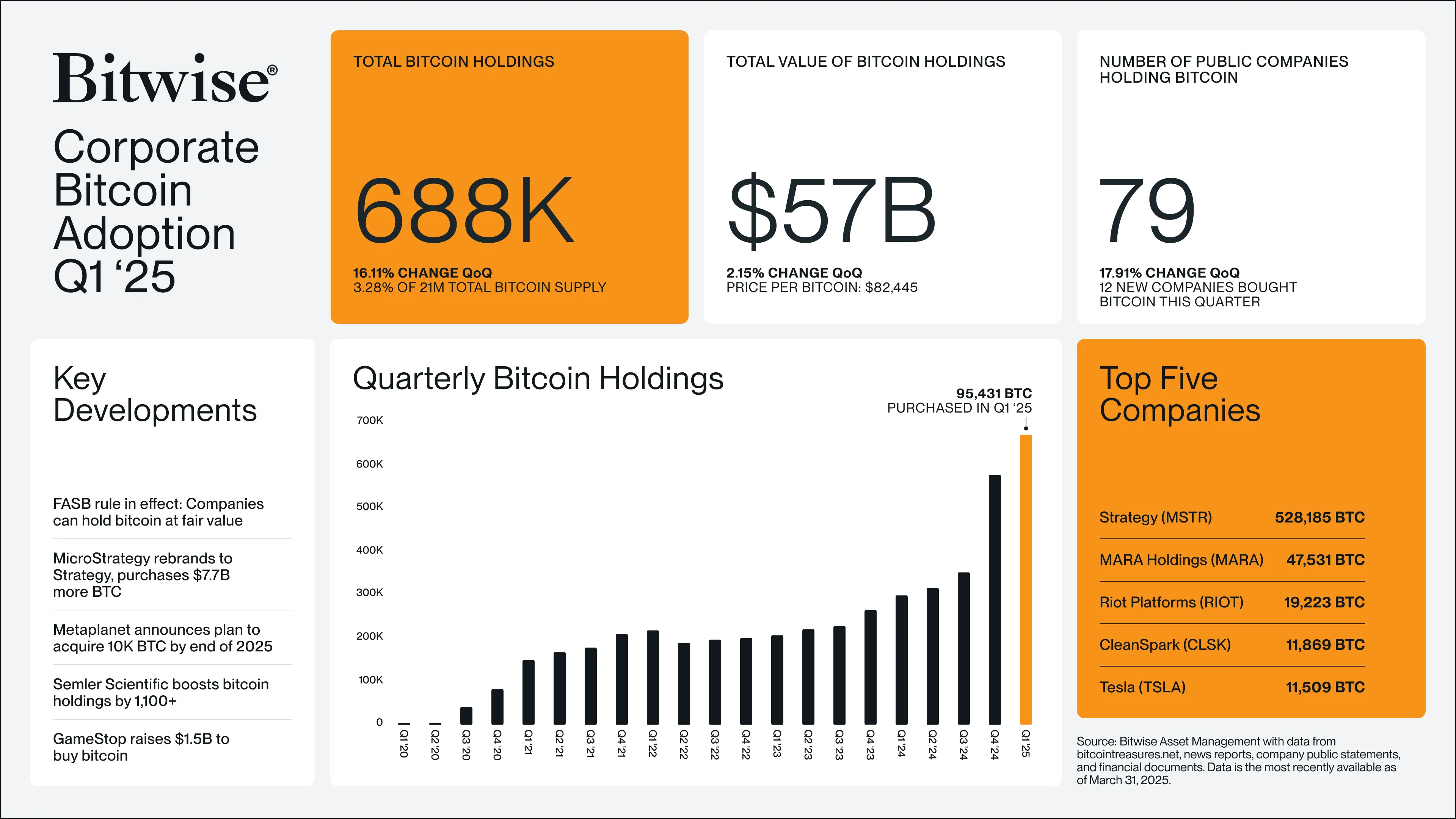
“People want to own Bitcoin. Corporations do too. 95,000 BTC purchased in Q1,” Bitwise CEO Hunter Horsley said.
With rising corporate demand and Bitcoin’s strong performance against traditional assets, the stage may be set for a major rally in summer 2025—driven by peak global liquidity and Bitcoin’s historic tendency to follow gold’s lead.
Disclaimer
In adherence to the Trust Project guidelines, BeInCrypto is committed to unbiased, transparent reporting. This news article aims to provide accurate, timely information. However, readers are advised to verify facts independently and consult with a professional before making any decisions based on this content. Please note that our Terms and Conditions, Privacy Policy, and Disclaimers have been updated.
Bitcoin
Crypto Outflows Hit $795 Million On Trump’s Tariffs & Market Fear

According to the latest CoinShares research, crypto outflows hit $795 million last week. This marks the third consecutive week of negative flows, as financial uncertainty continues to weigh heavy on investor sentiment.
This report aligns with the outlook for Bitcoin spot ETFs (exchange-traded funds), which saw $713 million in outflows last week, a 314% surge from the prior week’s $172.69 million.
Crypto Outflows Reached $795 Million Last Week
CoinShares’ researcher James Butterfill reveals that while Bitcoin led the outflows at $751 million, some altcoins, including XRP, Ondo Finance (ONDO), Algorand (ALGO, and Avalanche (AVAX), managed positive flows.
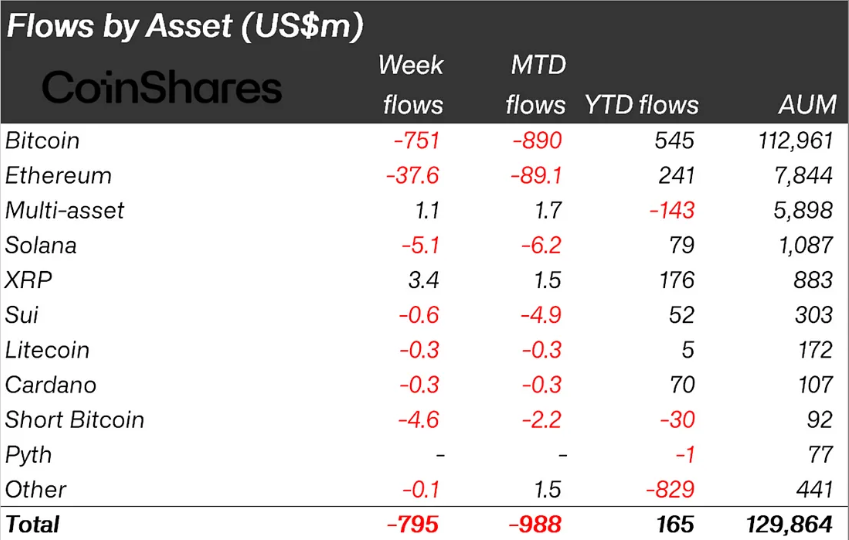
It suggests investors adjust their investment strategies, pivoting to altcoins as broader economic chaos bombards the Bitcoin (BTC) market.
“…recent tariff activity continues to weigh on sentiment towards the asset class,” wrote Butterfill.
This trend is not new, as altcoins have outperformed Bitcoin on flow metrics in the past. Two weeks ago, altcoins broke a five-week streak of negative flows, catapulting crypto inflows to $226 million.
Meanwhile, the influence of Trump’s tariffs on digital asset investment products has been consistent. In the week ending April 7, crypto outflows hit $240 million in the backdrop of Trump’s trade chaos.
Investor sentiment took a particularly sharp turn after President Donald Trump’s tariff pause announcement sidelined China, reigniting fears of a US-China trade war. This spooked markets across traditional and digital assets, along with China’s retaliatory move, exacerbates the sentiment.
Nevertheless, despite sidelining China, Trump’s temporary rollback of tariffs helped lift assets under management (AuM) by 8% to $130 billion, up from the lowest point seen since November 2024.
“… a late-week price rebound helped lift total AuM from their lowest point on April 8 (the lowest since early November 2024) to $130 billion, marking an 8% increase following President Trump’s temporary reversal of the economic calamitous tariffs,” Butterfill added.
Bitcoin Bleeds, ETF Flows Confirm Sentiment
As indicated, Bitcoin bore the brunt of last week’s bearish turn. Outflows surged in line with a 314% week-over-week increase in Bitcoin ETF outflows. The consistent bleed highlights that institutional interest is cooling, particularly among US-based ETF providers.
Short-Bitcoin products also suffered, with $4.6 million in outflows. This suggests traders may retreat to the sidelines entirely rather than taking leveraged bets on downside movement.
CoinShares emphasized that last week’s outflows spanned multiple regions and product providers. This signals that the bearish tone is not isolated to any one market. It aligns with broader risk-off behavior across equities and commodities in response to the volatile US trade stance.

Trump’s unpredictable tariff moves have reintroduced uncertainty into a fragile macro environment. Crypto markets, particularly institutional products, are responding with a broad withdrawal of capital.
Disclaimer
In adherence to the Trust Project guidelines, BeInCrypto is committed to unbiased, transparent reporting. This news article aims to provide accurate, timely information. However, readers are advised to verify facts independently and consult with a professional before making any decisions based on this content. Please note that our Terms and Conditions, Privacy Policy, and Disclaimers have been updated.
-

 Market21 hours ago
Market21 hours agoMENAKI Leads Cat Themed Tokens
-

 Market20 hours ago
Market20 hours agoTether Deploys Hashrate in OCEAN Bitcoin Mining Pool
-

 Market19 hours ago
Market19 hours ago3 Altcoins to Watch in the Third Week of April 2025
-

 Ethereum18 hours ago
Ethereum18 hours agoEthereum Price Threatened With Sharp Drop To $1,400, Here’s Why
-

 Market16 hours ago
Market16 hours agoBinance Futures Causes a Brief Crash For Story (IP) and ACT
-

 Market23 hours ago
Market23 hours agoSEC Delays Decision on Grayscale Ethereum ETF Staking
-

 Market14 hours ago
Market14 hours agoIs The XRP Price Mirroring Bitcoin’s Macro Action? Analyst Maps Out How It Could Get To $71
-

 Market22 hours ago
Market22 hours agoStrategy and Metaplanet Buy Bitcoin Despite Recession Fears




